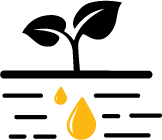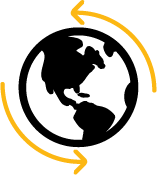 Tile Drainage
Tile DrainageTile drainage is the practice of placing underground pipes to provide a means for water to be removed from the soil. We use corrugated polyethylene (PE) pipes for all of our installations.
Years ago, concrete or clay “tiles” were used to drain excess water. Developing the name we know today “tile drainage”.
The pipe is perforated to allow water to seep in. It is buried throughout the field at a precise grade to allow the water to drain out, typically into a ditch or a creek. Resulting in the water table being lowered to a point where roots are no longer drowning, and capillary action can continue bringing usable water into the root zone.
 How is it installed?
How is it installed?We use commercially built tile plows that are controlled by GPS utilizing up to 32 satellites at once. The entire system is built around the accuracy of installation, which is critical for the tile to work effectively.
As with all technology, it’s the operator that makes something work. Our company is committed to using only highly qualified operators in all of our equipment.
Quality and accuracy are our number one concern with any drainage project.
 Will tile dry out the soil?
Will tile dry out the soil?The short answer is no. Without it, the additional water is causing the roots to drown from lack of oxygen. Once the tile drainage is installed, it only removes the excess water, which is taking up airspace from the soil. Leaving behind the “hygroscopic” water, for the plants to absorb.
 Environmental Impact
Environmental ImpactResearch has shown that installing tile drains artificially lowers the water table increasing the environmental benefits associated with this practice. When excess rainfall occurs, a field that is not tiled will “fill up”, causing the water table to rise closer to the surface, resulting in surface runoff. This overflow then carries out the soil particles, nutrients, and pesticides all with it. On the other hand, a field that is tiled has more room for the water to infiltrate and filter properly. Since the soil particles cannot enter the tile, the soil, nutrients, and pesticides stay on the field where they belong.
Nitrates, which are soluble, have a potential to leach through the soil with the movement of water. Either down into the water table or potentially off the surface together with the sediments if the soil remains inundated. Since tile drainage removes excess water, nitrates that have not been used up by the crop, and are dissolved in the soil moisture can be drawn downward and removed through the tile. We encourage “4R nutrient stewardship” to minimize this risk. 4R nutrient stewardship requires the implementation of best management practices (BMPs) that optimize the efficiency of fertilizer use. The goal of fertilizer BMPs is to match nutrient supply with crop requirements and to minimize nutrient losses from fields. Selection of BMPs varies by location, and those chosen for a given farm are dependent on local soil and climatic conditions, crop, management conditions and other site specific factors. The 4 Rs are Right source, Right rate, Right timing, Right placement.